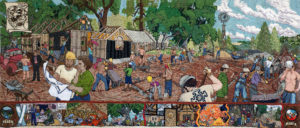69in L x 29½in H
Building Oak Tree School
The 6th tapestry in the San Juan Ridge Tapestry Project, “Building the Oak Tree School”, illustrates some of the events surrounding the building of the Oak Tree School in the 1970’s. Conceived as a community school, the architects and school boards members wanted the new school, a consolidation of three smaller schools on the Ridge, to reflect community ideals, using local labor and local materials. The emblem in the upper left hand corner is the final plan with the various buildings and rooms clustered together, yet separate in identify.
The second frame from the left in the bottom row of the tapestry has the five school board members, Syd Hall, Gene Stewart, Ida Belle Covert, Shelley Dachtler, and Richard Sisto, studying building plans.
The Shady Creek Construction company, Bruce Boyd, Jeff Gold and Holly Tornheim bid and were accepted to build the school. Bruce Boyd and Jeff Gold, both architects, are shown in the middle left side of the main tapestry, studying plans.
In order to pursue the Board’s plan for local people to be involved in the building process, a group of artists-craftsmen from the Padma City cooperative gallery formed the nucleus for a local union. The worker in the foreground with his back to us, modeled after Joel Goodkind, is wearing a white T-shirt with the Padma City logo.
Striking carpenter union members at the entrance to the work site are in the 3rd frame on the lower left side of the tapestry. Since no commercial company would cross the picket line to pour the foundation for the school, the contractors organized several all community work days to pour the foundation by hand. Hundreds of community members answered the call. They arrived with hard hat, boots and a wheelbarrow. Each wheelbarrow was numbered and coded with the type and amount of raw material it would carry. Steve Sanfield’s wheelbarrow is depicted in the middle of the tapestry.
Workers, modeled after community members, are depicted with various kinds of dress, from Stefani Freydont’s eye catching minimal outfit, to Bill Crosby’s bare upper torso, Chuck Dockhams’s head band, Clearwater’s loin cloth, Gloria’s overalls, and Shelly Dachtler’s straw hat.
At the left side of the tapestry, a load of cement bags has arrived in a l946 Diamond T Rio, driven by Tom Walsh and loaned for the job by Steve Beckwitt and a consortium of local folks.
In the main scene, wheel barrows of raw materials are transported from piles at the right rear to Shelley Dachtler’s weighing station with a scale loaned by the Coughlans.
The wheelbarrows with raw materials emptied their contents into a trough at the front of one of a pair of one-third ton cement mixers at the right edge of the tapestry. Wood barriers protect the wheelbarrow workers from getting too close to their troughs.
One of the machines in service at the far right of the tapestry was found in a vacant field and resurrected by Steve Beckwitt, Gene Stewart and other local mechanics. While serviceable, this “vacant lot” machine did occasionally drop its trough, hence the wooden barrier at the front of the machines. It’s radiator was also beyond repair, so a hose of running water was put inside all day.
The second cement mixer, built by the Milwaukee Koehring Company in the 1930s, was tended each day by its two owners, brothers Ron and Richard Merkens from Graniteville. The previously mentioned 1946 Diamond T Rio transported this machine, the” Dandee”, from Graniteville to the Oak Tree site.
The concrete was poured into wheelbarrows at the rear of the machines, trundled to the open trenches, dumped with the help of two or three other people and then spread by hand. Stefanie Freydont, stitched in the lower middle, is working the agitator to help settle the cement. .
In the background of the tapestry, other stages in the construction of the school are shown. In a tree former high steel worker Peter Blue Cloud has rigged ropes to assist in pushing up the trusses safely.
The bottom row continues with more parts of the Oak Tree story. In one scene, the weekly Wednesday lunch local history event, Jimmy Coughlan and Father McGarrity visited to talk about the old days on the Ridge.
Next in the bottom row, the architecture of the lodge and Chuck Dockham’s hand carved door were just two of the many unusual features for public school.
Less than a year after its completion in 1976, the Oak Tree School burned down. Children, parents and community members were shocked by the loss of their beautiful new school. The school was soon rebuilt, with a new stained glass window of a phoenix, the final section of the bottom panel.
Stitchers of this tapestry included: Nici von Kriedt, Tamara Sindorf, Laughter Medicine, Starlight Kompost, Mary Moore, Ryah Zelli Souverville, Carol Meals, Hank Meals, Barbara MacQuiddy, Cicada Nikohl, Pat Smith, Greta Broda,
Susan Moser, Holly Cheatum, Tai Smith, Simi Tecklin, Josh Tecklin, Allison Schell, Catherine Hogan, Annalinde, Masa Uehara, Jane Price Hill , Autumn Blackshear, Becky Smith, Luke Graddel, Marsha Stone and many visitors to the Resource Center where the tapestry was stitched.

